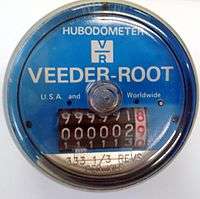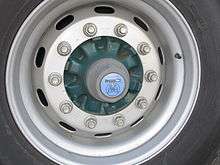Hubometer
A hubometer (hub, center of a wheel + -ometer, measure of), or hubodometer or simply hubo, is a device mounted on the axle of an automobile or other land vehicle that measures distance traveled.


The whole device rotates with the wheel except for an eccentrically mounted weight on an internal shaft. This remains pointing downwards and drives the counting mechanism as the body of the hubometer rotates round it.
Typical uses
They are needed on semi-trailers where they are the only means of measuring distance traveled over the lifetime of a tire or the trailer.
They are used on bus or truck or trailer wheels where the tires are supplied to the vehicle operator by an independent company on a contract of "price per thousand kilometers". The hubometer is installed by the tire company to give them their own measure.
In New Zealand hubodometers are used for the calculation of road user charges [1] for HGVs powered by a fuel not taxed at source.
Historical data
One of the first hubodometers was designed by Howard G. Engler, co-founder of Engler Instruments with his brother, Clifford E. Engler, in 1952. Numerous attempts at electronic versions have been attempted, including a Stemco version patented in 1991 (pat #4,989,222). The first hubodometer with no moving parts was made by Stemco and released in 2002 under the name DataTrac, patent number 6,940,940 granted in 2005. This part was then made programmable in 2006. An improved version of the DataTrac, which utilizes two 3-axis accelerometers, was released in 2011 under patent number 8,352,210 (granted Jan 2013). The additional 3-axis device allows updates to the counting algorithms so that the device can now be used in off-road applications with high vibrations and instantaneous accelerations. The system now uses a differential acceleration analysis to extract distance from the center of the wheel, allowing for increased accuracies. The display now stays on at low speeds so that the counting operations can be viewed in realtime.
See also
- Odometer
- Speedometer
- Tachograph
- Tachometer
- Taximeter
- Hobbs meter
- Tach Timer
References
- Road user charges handbook, ISSN 1176-9297